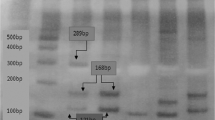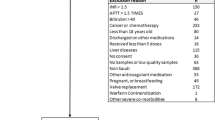Abstract
We report a novel combination of factors that explains almost 60% of variable response to warfarin. Warfarin is a widely used anticoagulant, which acts through interference with vitamin K epoxide reductase that is encoded by VKORC1. In the next step of the vitamin K cycle, gamma-glutamyl carboxylase encoded by GGCX uses reduced vitamin K to activate clotting factors. We genotyped 201 warfarin-treated patients for common polymorphisms in VKORC1 and GGCX. All the five VKORC1 single-nucleotide polymorphisms covary significantly with warfarin dose, and explain 29–30% of variance in dose. Thus, VKORC1 has a larger impact than cytochrome P450 2C9, which explains 12% of variance in dose. In addition, one GGCX SNP showed a small but significant effect on warfarin dose. Incorrect dosage, especially during the initial phase of treatment, carries a high risk of either severe bleeding or failure to prevent thromboembolism. Genotype-based dose predictions may in future enable personalised drug treatment from the start of warfarin therapy.
This is a preview of subscription content, access via your institution
Access options
Subscribe to this journal
Receive 6 print issues and online access
$259.00 per year
only $43.17 per issue
Buy this article
- Purchase on Springer Link
- Instant access to full article PDF
Prices may be subject to local taxes which are calculated during checkout






Similar content being viewed by others
Abbreviations
- CYP2C9:
-
cytochrome P450 2C9
- ddNTP:
-
dideoxynucleotide triphosphate
- dNTP:
-
deoxynucleotide triphosphate
- GGCX:
-
gamma-glutamyl carboxylase
- LD:
-
linkage disequilibrium
- PCR:
-
polymerase chain reaction
- PT INR:
-
prothrombin time international normalised ratio
- UTR:
-
untranslated region
- VKOR:
-
vitamin K epoxide reductase
- VKORC1:
-
vitamin K epoxide reductase complex subunit 1
References
Scordo MG, Pengo V, Spina E, Dahl ML, Gusella M, Padrini R . Influence of CYP2C9 and CYP2C19 genetic polymorphisms on warfarin maintenance dose and metabolic clearance. Clin Pharmacol Ther 2002; 72: 702–710.
Aithal G, Day C, Kesteven P, Daly A . Association of polymorphisms in the cytochrome P450 CYP2C9 with warfarin dose requirement and risk of bleeding complications. Lancet 1999; 353: 689–717.
Wadelius M, Sörlin K, Wallerman O, Karlsson J, Yue QY, Magnusson PK et al. Warfarin sensitivity related to CYP2C9, CYP3A5, ABCB1 (MDR1) and other factors. Pharmacogenomics J 2004; 4: 40–48.
van den Besselaar AM . Standardization of the prothrombin time in oral anticoagulant control. Haemostasis 1985; 15: 271–277.
Takahashi H, Echizen H . Pharmacogenetics of CYP2C9 and interindividual variability in anticoagulant response to warfarin. Pharmacogenomics J 2003; 3: 202–214.
Landefeld C, Beyth R . Anticoagulant-related bleeding: clinical epidemiology, prediction and prevention. Am J Med 1993; 95: 315–328.
Mathiesen T, Benediktsdottir K, Johnsson H, Lindqvist M, von Holst H . Intracranial traumatic and non-traumatic haemorrhagic complications of warfarin treatment. Acta Neurol Scand 1995; 91: 208–214.
Levine M, Raskob G, Landefeld S, Kearon C . Hemorrhagic complications of anticoagulant treatment. Chest 1998; 114: 511S–523S.
Pirmohamed M, James S, Meakin S, Green C, Scott AK, Walley TJ et al. Adverse drug reactions as cause of admission to hospital: prospective analysis of 18 820 patients. BMJ 2004; 329: 15–19.
Runciman WB, Roughead EE, Semple SJ, Adams RJ . Adverse drug events and medication errors in Australia. Int J Qual Health Care 2003; 15 (Suppl 1): i49–59.
Loebstein R, Yonath H, Peleg D, Almog S, Rotenberg M, Lubetsky A et al. Interindividual variability in sensitivity to warfarin—nature or nurture? Clin Pharmacol Ther 2001; 70: 159–164.
Gage BF, Eby CS . Pharmacogenetics and anticoagulant therapy. J Thromb Thrombolysis 2003; 16: 73–78.
Kamali F, Khan TI, King BP, Frearson R, Kesteven P, Wood P et al. Contribution of age, body size, and CYP2C9 genotype to anticoagulant response to warfarin. Clin Pharmacol Ther 2004; 75: 204–212.
Hillman MA, Wilke RA, Caldwell MD, Berg RL, Glurich I, Burmester JK . Relative impact of covariates in prescribing warfarin according to CYP2C9 genotype. Pharmacogenetics 2004; 14: 539–547.
Daly AK, King BP . Pharmacogenetics of oral anticoagulants. Pharmacogenetics 2003; 13: 247–252.
Rettie AE, Korzekwa KR, Kunze KL, Lawrence RF, Eddy AC, Aoyama T et al. Hydroxylation of warfarin by human cDNA-expressed cytochrome P-450: a role for P-4502C9 in the etiology of (S)-warfarin–drug interactions. Chem Res Toxicol 1992; 5: 54–59.
Takahashi H, Echizen H . Pharmacogenetics of warfarin elimination and its clinical implications. Clin Pharmacokinet 2001; 40: 587–603.
Kaminsky L, Zhang Z . Human P450 metabolism of warfarin. Pharmacol Ther 1997; 73: 67–74.
Xie HG, Prasad HC, Kim RB, Stein CM . CYP2C9 allelic variants: ethnic distribution and functional significance. Adv Drug Deliv Rev 2002; 54: 1257–1270.
Furuya H, Fernandez-Salguero P, Gregory W, Taber H, Steward A, Gonzalez FJ et al. Genetic polymorphism of CYP2C9 and its effect on warfarin maintenance dose requirement in patients undergoing anticoagulation therapy. Pharmacogenetics 1995; 5: 389–392.
Margaglione M, Colaizzo D, D'Andrea G, Brancaccio V, Ciampa A, Grandone E et al. Genetic modulation of oral anticoagulation with warfarin. Thromb Haemost 2000; 84: 775–778.
Tabrizi AR, Zehnbauer BA, Borecki IB, McGrath SD, Buchman TG, Freeman BD . The frequency and effects of cytochrome P450 (CYP) 2C9 polymorphisms in patients receiving warfarin. J Am Coll Surg 2002; 194: 267–273.
Taube J, Halsall D, Baglin T . Influence of cytochrome P-450 CYP2C9 polymorphisms on warfarin sensitivity and risk of over-anticoagulation in patients on long-term treatment. Blood 2000; 96: 1816–1819.
Higashi M, Veenstra D, Kondo L, Wittkowsky A, Srinouanprachanh S, Farin F et al. Association between CYP 2C9 genetic variants and anticoagulation-related outcomes during warfarin treatment. JAMA 2002; 287: 1690–1698.
Sadler JE . Medicine: K is for koagulation. Nature 2004; 427: 493–494.
Linder MW . Genetic mechanisms for hypersensitivity and resistance to the anticoagulant Warfarin. Clin Chim Acta 2001; 308: 9–15.
Bell RG . Metabolism of vitamin K and prothrombin synthesis: anticoagulants and the vitamin K–epoxide cycle. Fed Proc 1978; 37: 2599–2604.
Bell RG, Sadowski JA, Matschiner JT . Mechanism of action of warfarin. Warfarin and metabolism of vitamin K 1. Biochemistry 1972; 11: 1959–1961.
Begent LA, Hill AP, Steventon GB, Hutt AJ, Pallister CJ, Cowell DC . Characterization and purification of the vitamin K1 2,3 epoxide reductases system from rat liver. J Pharm Pharmacol 2001; 53: 481–486.
Fregin A, Rost S, Wolz W, Krebsova A, Muller CR, Oldenburg J . Homozygosity mapping of a second gene locus for hereditary combined deficiency of vitamin K-dependent clotting factors to the centromeric region of chromosome 16. Blood 2002; 100: 3229–3232.
Rost S, Fregin A, Ivaskevicius V, Conzelmann E, Hortnagel K, Pelz HJ et al. Mutations in VKORC1 cause warfarin resistance and multiple coagulation factor deficiency type 2. Nature 2004; 427: 537–541.
Li T, Chang CY, Jin DY, Lin PJ, Khvorova A, Stafford DW . Identification of the gene for vitamin K epoxide reductase. Nature 2004; 427: 541–544.
Harrington DJ, Underwood S, Morse C, Shearer MJ, Tuddenham EG, Mumford AD . Pharmacodynamic resistance to warfarin associated with a Val66Met substitution in vitamin K epoxide reductase complex subunit 1. Thromb Haemost 2005; 93: 23–26.
Rost S, Fregin A, Koch D, Compes M, Muller CR, Oldenburg J . Compound heterozygous mutations in the gamma-glutamyl carboxylase gene cause combined deficiency of all vitamin K-dependent blood coagulation factors. Br J Haematol 2004; 126: 546–549.
Suttie JW, Canfield LM, Shah DV . Microsomal vitamin K-dependent carboxylase. Methods Enzymol 1980; 67: 180–185.
Berkner KL, McNally BA . Purification of vitamin K-dependent carboxylase from cultured cells. Methods Enzymol 1997; 282: 313–333.
Lingenfelter SE, Berkner KL . Isolation of the human gamma-carboxylase and a gamma-carboxylase-associated protein from factor IX-expressing mammalian cells. Biochemistry 1996; 35: 8234–8243.
Kuo WL, Stafford DW, Cruces J, Gray J, Solera J . Chromosomal localization of the gamma-glutamyl carboxylase gene at 2p12. Genomics 1995; 25: 746–748.
Wu SM, Stafford DW, Frazier LD, Fu YY, High KA, Chu K et al. Genomic sequence and transcription start site for the human gamma-glutamyl carboxylase. Blood 1997; 89: 4058–4062.
Gabriel SB, Schaffner SF, Nguyen H, Moore JM, Roy J, Blumenstiel B et al. The structure of haplotype blocks in the human genome. Science 2002; 296: 2225–2229.
D'Andrea G, D'Ambrosio RL, Di Perna P, Chetta M, Santacroce R, Brancaccio V et al. A polymorphism in the VKORC1 gene is associated with an interindividual variability in the dose-anticoagulant effect of warfarin. Blood 2005; 105: 645–649.
Yasar U, Elisson E, Dahl M, Johansson I, Ingelman-Sundberg M, Sjökvist F . Validation of methods for CYP2C9 genotyping: frequencies of mutant alleles in a Swedish population. Biochem Biophys Res Commun 1999; 254: 628–631.
Shikata E, Ieiri I, Ishiguro S, Aono H, Inoue K, Koide T et al. Association of pharmacokinetic (CYP2C9) and pharmacodynamic (factors II, VII, IX, and X; proteins S and C; and gamma-glutamyl carboxylase) gene variants with warfarin sensitivity. Blood 2004; 103: 2630–2635.
Gage BF, Eby C, Milligan PE, Banet GA, Duncan JR, McLeod HL . Use of pharmacogenetics and clinical factors to predict the maintenance dose of warfarin. Thromb Haemost 2004; 91: 87–94.
Whittaker P, Bumpstead S, Downes K, Ghori J, Deloukas P . SNP analysis by MALDI-TOF mass spectrometry. In: Celis J, Carter N, Simons K, Small JV, Hunter T, Shotton D (eds). 3rd ed. Cell Biology: A Laboratory Handbook. Amsterdam: Elsevier, 2005.
Dudbridge F . Pedigree disequilibrium tests for multilocus haplotypes. Genet Epidemiol 2003; 25: 115–121.
Pritchard JK, Przeworski M . Linkage disequilibrium in humans: models and data. Am J Hum Genet 2001; 69: 1–14.
Acknowledgements
We are grateful to all nurses, doctors and patients who took part in the study. We thank Kristina Sörlin for going through medical records, Liz Sheridan for gene annotation, Suzannah Bumpstead for technical assistance, David Vetrie for introduction to databases and Ralph McGinnis for critical reading of the manuscript. This study was funded by the Wellcome Trust, and the Swedish Society of Medicine, Swedish Research Council (M521-2003-5730, NT621-2003-5592), Foundation for Strategic Research, Heart and Lung Foundation, Tore Nilson foundation, Federation of County Councils and Clinical Research Support (ALF) at Uppsala University. The sponsors had no role in study design, data collection, data analysis, data interpretation or writing of the report. Ethical approval: Uppsala Research Ethics Committee approved the study, no. 00-119.
Author information
Authors and Affiliations
Corresponding author
Additional information
DUALITY OF INTEREST
None declared.
Rights and permissions
About this article
Cite this article
Wadelius, M., Chen, L., Downes, K. et al. Common VKORC1 and GGCX polymorphisms associated with warfarin dose. Pharmacogenomics J 5, 262–270 (2005). https://doi.org/10.1038/sj.tpj.6500313
Received:
Revised:
Accepted:
Published:
Issue Date:
DOI: https://doi.org/10.1038/sj.tpj.6500313
Keywords
This article is cited by
-
Effect of gene polymorphism on bleeding complications in Chinese Han patients taking warfarin
European Journal of Clinical Pharmacology (2022)
-
Genetic polymorphisms associated with upper gastrointestinal bleeding: a systematic review
The Pharmacogenomics Journal (2021)
-
Personalized medicine in cardiovascular disease: review of literature
Journal of Diabetes & Metabolic Disorders (2021)
-
Current formulation approaches in design and development of solid oral dosage forms through three-dimensional printing
Progress in Additive Manufacturing (2020)
-
Long-term integrity protection of genomic data
EURASIP Journal on Information Security (2019)



